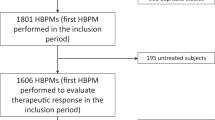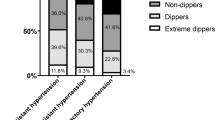Abstract
In diagnosis of treatment-resistant hypertension (TRH), guidelines recommend out-of-office blood pressure (BP) measurements, ambulatory BP monitoring (ABPM) and home BP monitoring (HBPM). Although evidence of an association between ABPM-evaluated TRH and cardiovascular disease (CVD) prognosis has accumulated, data are sparse regarding HBPM-evaluated TRH. We investigated this issue using data from the nationwide practice-based J-HOP (Japan Morning-Surge Home BP) study, which recruited 4,261 outpatients (mean age 64.9 years; 46.8% men; 91.5% hypertensives) who underwent morning and evening HBPM for 14 days. During 6.2 ± 3.8 years (26,418 person-years) follow-up, 270 total CVDs (stroke, coronary artery disease, aortic dissection, and heart failure) occurred. The adjusted hazard ratio (HR) (95% CIs) of uncontrolled TRH, i.e., uncontrolled BP using 3 classes of medications including diuretics or ≥4 classes of medications, for total CVD risk compared to controlled BP using <3 classes were 2.02 (1.38–2.94) and 1.81 (1.23–2.65) in home BP of 135/85 mmHg and 130/80 mmHg, respectively. Additionally, patients with TRH defined by guidelines, i.e., uncontrolled BP using 3 classes of medications including diuretics or controlled/uncontrolled BP using ≥4 classes of medications, also had higher total CVD risk compared to non-TRH under all home BP criteria. Moreover, in patients with uncontrolled apparent-TRH, i.e., TRH defined by office BP, uncontrolled home BP (≥135/85 mmHg) was still associated with atherosclerotic CVD (CVDs except heart failure) risk (adjusted HR [95% CI], 2.38 [1.09–5.19]). This is the first study to demonstrate an independent association between TRH evaluated by HBPM and CVD outcomes.
This is a preview of subscription content, access via your institution
Access options
Subscribe to this journal
Receive 12 print issues and online access
$259.00 per year
only $21.58 per issue
Buy this article
- Purchase on Springer Link
- Instant access to full article PDF
Prices may be subject to local taxes which are calculated during checkout


Similar content being viewed by others
References
Lawes CMM, Vander Hoorn S, Rodgers A, International Society of Hypertension. Global burden of blood-pressure-related disease, 2001. Lancet 2008;371:1513–8.
Kearney PM, Whelton M, Reynolds K, Muntner P, Whelton PK, He J. Global burden of hypertension: analysis of worldwide data. Lancet 2005;365:217–23.
Armstrong C, Joint National Committee. JNC8 guidelines for the management of hypertension in adults. Am Fam Physician. 2014;90:503–4.
Bundy JD, Li C, Stuchlik P, Bu X, Kelly TN, Mills KT, et al. Systolic blood pressure reduction and risk of cardiovascular disease and mortality: a systematic review and network meta-analysis. JAMA Cardiol. 2017;2:775–81.
Carey RM, Calhoun DA, Bakris GL, Brook RD, Daugherty SL, Dennison-Himmelfarb CR.American Heart Association Proffesional/Public Education and Publications Committee of the Council on Hypertension; Council on Cardiovascular and Stroke Nursing; Council on Clinical Cardiology; Council on Genomic and Precision Medicine; Council on Peripheral Vascular Disease; Council on Quality of Care and Outcomes Research; and Stroke Council. et al. Resistant hypertension: detection, evaluation, and management: a scientific statement from the American Heart Association. Hypertension. 2018;72:e53–e90.
Whelton PK, Carey RM, Aronow WS, Casey DE, Collins KJ, Dennison Himmelfarb C, et al. 2017 ACC/AHA/AAPA/ABC/ ACPM/AGS/APhA/ASH/ASPC/NMA/PCNA guideline for the prevention, detection, evaluation, and management of high blood pressure in adults: a report of the American College of Cardiology/American Heart Association task force on clinical practice guidelines. Hypertension. 2018;71:e13–e115.
Williams B, Mancia G, Spiering W, Agabiti Rosei E, Azizi M, Burnier M.ESC Scientific Document Group et al. 2018 ESC/ESH Guidelines for the management of arterial hypertension. Eur Heart J. 2018;39:3021–104.
Umemura S, Arima H, Arima S, Asayama K, Dohi Y, Hirooka Y, et al. The Japanese Society of Hypertension guidelines for the management of hypertension (JSH2019). Hypertens Res. 2019;42:1235–481.
Chernova I, Krishnan N. Resistant hypertension updated guidelines. Curr Cardiol Rep. 2019;21:117.
Tsioufis C, Kasiakogias A, Kordalis A, Dimitriadis K, Thomopoulos C, Tsiachris D, et al. Dynamic resistant hypertension patterns as predictors of cardiovascular morbidity: a 4-year prospective study. J Hypertens. 2014;32:415–22.
Pierdomenico SD, Lapenna D, Bucci A, Di Tommaso R, Di Mascio R, Manente BM, et al. Cardiovascular outcome in treated hypertensive patients with responder, masked, false resistant, and true resistant hypertension. Am J Hypertens. 2005;18:1422–8.
Salles GF, Cardoso CRL, Muxfeldt ES. Prognostic influence of office and ambulatory blood pressures in resistant hypertension. Arch Intern Med. 2008;168:2340–6.
Muxfeldt ES, Cardoso CRL, Salles GF. Prognostic value of nocturnal blood pressure reduction in resistant hypertension. Arch Intern Med. 2009;169:874–80.
Cuspidi C, Vaccarella A, Negri F, Sala C. Resistant hypertension and left ventricular hypertrophy: an overview. J Am Soc Hypertens. 2010;4:319–24.
Cuspidi C, Macca G, Sampieri L, Michev I, Salerno M, Fusi V, et al. High prevalence of cardiac and extracardiac target organ damage in refractory hypertension. J Hypertens. 2001;19:2063–70.
Oliveras A, de la Sierra A. Resistant hypertension: patient characteristics, risk factors, co-morbidities and outcomes. J Hum Hypertens. 2014;28:213–7.
Oliveras A, Armario P, Hernández-Del Rey R, Arroyo JA, Poch E, Larrousse M, et al. Urinary albumin excretion is associated with true resistant hypertension. J Hum Hypertens. 2010;24:27–33.
Gaddam KK, Nishizaka MK, Pratt-Ubunama MN, Pimenta E, Aban I, Oparil S, et al. Characterization of resistant hypertension: association between resistant hypertension, aldosterone, and persistent intravascular volume expansion. Arch Intern Med. 2008;168:1159–64.
Hoshide S, Yano Y, Haimoto H, Yamagiwa K, Uchiba K, Nagasaka S, J-HOP Study Group. et al. Morning and evening home blood pressure and risks of incident stroke and coronary artery disease in the Japanese general practice population: the Japan Morning Surge-Home Blood Pressure Study. Hypertension. 2016;68:54–61.
Hoside S, Yano Y, Mizuno H, Kanegae H, Kario K. Day-by-day variability of home blood pressure and incident cardiovascular disease in clinical pracitice. The J-HOP study (Japan Morning Surge-Home Blood Pressure). Hypertension. 2018;71:177–84.
Imai Y, Otsuka K, Shimada K, Hayashi H, Tochikubo O, Miyakawa M.Japanese Society of Hypertension et al. Japanese Society of Hypertension (JSH) guidelines for self-monitoring of blood pressure at home. Hypertens Res. 2003;26:771–82.
Sega R, Facchetti R, Bombelli M, Cesana G, Corrao G, Grassi G, et al. Prognostic value of ambulatory and home blood pressure compared with office blood pressure in the general population: follow-up results from the Pression Arteriose Monitorate e Loro Assocoazioni (PAMELA) study. Circulation 2005;111:1777–1783.
Niiranen TJ, Hanninen MR, Johansson J, Reunanen A, Jula AM. Home-measured blood pressure is a stronger predictor of cardiovascular risk than office blood pressure: the Finn-Home Study. Hypertension. 2010;55:1346–51.
Asayama K, Ohkubo T, Kikuya M, Obara T, Metoki H, Inoue R, et al. Prediction of stroke by home “morning” versus “evening” blood pressure values: the Ohasama study. Hypertension. 2006;48:737–43.
Hillege HL, Fidler V, Diercks GFH, van Gilst WH, de Zeeuw D, van Veldhuisen DJ.Prevention of Renal and Vascular End Stage Disease (PREVEND) Study Group et al. Urinary albumin excretion predicts cardiovascular and noncardiovascular mortality in general population. Circulation. 2002;106:1777–82.
Matsushita K, van der Velde M, Astor BC, Woodward M, Levey AS, de Jong PE.Chronic Kidney Disease Prognosis Consortium et al. Association of estimated glomerular filtration rate and albuminuria with all-cause and cardiovascular mortality in general population cohorts: a collaborative meta-analysis. Lancet. 2010;375:2073–81.
Doust JA, Pietrzak E, Dobson A, Glasziou P. How well does B-type natriuretic peptide predict death and cardiac events in patients with heart failure: systematic review. BMJ. 2005;330:625.
Sarzani R, Spannella F, Giulietti F, Balietti P, Cocci G, Bordicchia M. Cardiac natriuretic peptides, hypertension and cardiovascular risk. High Blood Press Cardiovasc Prev. 2017;24:115–26.
Shimamoto K, Ando K, Fujita T, Hasebe N, Higaki J, Horiuchi M.Japanese Society of Hypertension Committee for Guidelines for the Management of Hypertension et al. The Japanese Society of Hypertension Guidelines for the Management of Hypertension (JSH 2014). Hypertens Res. 2014;37:253–253.
Chobanian AV, Bakris GL, Black HR, Cushman WC, Green LA, Izzo JL.National Heart, Lung, and Blood Institute Joint National Committee on Prevention, Detection, Evaluation, and Treatment of High Blood Pressure; National High Blood Pressure Education Program Coordinating Committee. et al. The Seventh Report of the Joint National Committee on Prevention, Detection, Evaluation, and Treatment of High Blood Pressure: the JNC 7 report. JAMA. 2003;289:2560–72.
D’Agostino RB Sr, Vasan RS, Pencina MJ, Wolf PA, Cobain M, Massaro JM, et al. General cardiovascular risk profile for use in primary care: the Framingham Heart Study. Circulation. 2008;117:743–53.
Pickering TG, Shimbo D, Haas D. Ambulatory blood-pressure monitoring. N Engl J Med. 2006;354:2368–74.
Imai Y, Obara T, Asamaya K, Ohkubo T. The reason why home blood pressure measurements are preferred over clinic or ambulatory blood pressure in Japan. Hypertens Res. 2013;36:661–72.
Kario K, Shimbo D, Hoshide S, Wang JG, Asayama K, Ohkubo T, et al. Emergence of home blood pressure-guided management of hypertension based on global evidence. Hypertension. 2019;74:229–236.
Kario K. State-of-the-Art review: home blood pressure monitoring: current status and new developments. Am J Hypertens. 2021;34:783–794. https://doi.org/10.1093/ajh/hpab017. Online ahead of print.
De Nicola L, Gabbai FB, Agarwal R, Chiodini P, Borrelli S, Bellizzi V, et al. Prevalence and prognostic role of resistant hypertension in chronic kidney disease patients. J Am Coll Cardiol. 2013;61:2461–7.
Irvin MR, Booth JN, Shimbo D, Lackland DT, Oparil S, Howard G, et al. Apparent treatment-resistant hypertension and risk for stroke, coronary heart disease, and all-cause mortality. J Am Soc Hypertens. 2014;8:405–13.
Holmqvist L, Boström KB, Kahan T, Schiöler L, Hasselström J, Hjerpe P, et al. Cardiovascular outcome in treatment-resistant hypertension: results from the Swedish Primary Care Cardiovascular Database (SPCCD). J Hypertens. 2018;36:402–9.
Daugherty SL, Powers JD, Magid DJ, Tavel HM, Masoudi FA, Margolis KL, et al. Incidence and prognosis of resistant hypertension in hypertensive patients. Circulation. 2012;125:1635–42.
Muntner P, Davis BR, Cushman WC, Bangalore S, Calhoun DA, Pressel SL, ALLHAT Collaborative Research Group. et al. Treatment-resistant hypertension and the incidence of cardiovascular disease and end-stage renal disease: results from the Antihypertensive and Lipid-Lowering Treatment to Prevent Heart Attack Trial (ALLHAT). Hypertension. 2014;64:1012–21.
Acknowledgements
We gratefully acknowledge the numerous study investigators and participants in the J-HOP study.
Author information
Authors and Affiliations
Contributions
Kario K takes primary responsibility for this paper. Narita K analyzed the data and performed the literature research, writing the paper. Kario K and Hoshide S collected the patients’ data. All authors conceived and designed the entire study and reviewed/edited the manuscript.
Funding information
This study was financially supported, in part, by a grant from the 21st Century Center of Excellence Project run by Japan’s Ministry of Education, Culture, Sports, Science, and Technology (MEXT); a grant from the Foundation for Development of the Community (Tochigi); a grant from Omron Healthcare Co., Ltd.; a Grant-in-Aid for Scientific Research (B; 21390247) from The Ministry of Education, Culture, Sports, Science, and Technology of Japan, 2009 to 2013; and funds from the MEXT-supported program for the Strategic Research Foundation at Private Universities, 2011–2015 Cooperative Basic and Clinical Research on Circadian Medicine (S1101022) to KK. Funding sponsors had no role in the design or performance of the study; in the collection, management, analysis, or interpretation of the data; in the preparation of the article; or in the decision to submit the article for publication.
Corresponding author
Ethics declarations
Conflict of interest
KK received research funding from Omron Healthcare Co., Fukuda Denshi, and A&D Co. The other authors declare no competing interests.
Additional information
Publisher’s note Springer Nature remains neutral with regard to jurisdictional claims in published maps and institutional affiliations.
Supplementary information
Rights and permissions
About this article
Cite this article
Narita, K., Hoshide, S. & Kario, K. Association of treatment-resistant hypertension defined by home blood pressure monitoring with cardiovascular outcome. Hypertens Res 45, 75–86 (2022). https://doi.org/10.1038/s41440-021-00757-4
Received:
Revised:
Accepted:
Published:
Issue Date:
DOI: https://doi.org/10.1038/s41440-021-00757-4
Keywords
This article is cited by
-
Therapeutic intervention exploring hypertensive patients who respond to health coaching behavior modification therapy
Hypertension Research (2024)
-
Role of home blood pressure monitoring in resistant hypertension
Clinical Hypertension (2023)
-
Resistant hypertension: consensus document from the Korean society of hypertension
Clinical Hypertension (2023)
-
Concept, study design, and baseline blood pressure control status of the nationwide prospective HI–JAMP study using multisensor ABPM
Hypertension Research (2023)
-
Denervation or stimulation? Role of sympatho-vagal imbalance in HFpEF with hypertension
Hypertension Research (2023)



